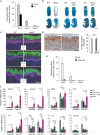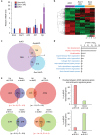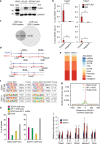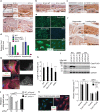SOX11 and SOX4 drive the reactivation of an embryonic gene program during murine wound repair
- PMID: 31492871
- PMCID: PMC6731344
- DOI: 10.1038/s41467-019-11880-9
SOX11 and SOX4 drive the reactivation of an embryonic gene program during murine wound repair
Abstract
Tissue injury induces changes in cellular identity, but the underlying molecular mechanisms remain obscure. Here, we show that upon damage in a mouse model, epidermal cells at the wound edge convert to an embryonic-like state, altering particularly the cytoskeletal/extracellular matrix (ECM) components and differentiation program. We show that SOX11 and its closest relative SOX4 dictate embryonic epidermal state, regulating genes involved in epidermal development as well as cytoskeletal/ECM organization. Correspondingly, postnatal induction of SOX11 represses epidermal terminal differentiation while deficiency of Sox11 and Sox4 accelerates differentiation and dramatically impairs cell motility and re-epithelialization. Amongst the embryonic genes reactivated at the wound edge, we identify fascin actin-bundling protein 1 (FSCN1) as a critical direct target of SOX11 and SOX4 regulating cell migration. Our study identifies the reactivated embryonic gene program during wound repair and demonstrates that SOX11 and SOX4 play a central role in this process.
Conflict of interest statement
The authors declare no competing interests.
Figures









Similar articles
-
Transcription factors SOX4 and SOX11 function redundantly to regulate the development of mouse retinal ganglion cells.J Biol Chem. 2013 Jun 21;288(25):18429-38. doi: 10.1074/jbc.M113.478503. Epub 2013 May 6. J Biol Chem. 2013. PMID: 23649630 Free PMC article.
-
The early retinal progenitor-expressed gene Sox11 regulates the timing of the differentiation of retinal cells.Development. 2013 Feb;140(4):740-50. doi: 10.1242/dev.090274. Epub 2013 Jan 14. Development. 2013. PMID: 23318640
-
Molecular networks involved in mouse cerebral corticogenesis and spatio-temporal regulation of Sox4 and Sox11 novel antisense transcripts revealed by transcriptome profiling.Genome Biol. 2009;10(10):R104. doi: 10.1186/gb-2009-10-10-r104. Epub 2009 Oct 2. Genome Biol. 2009. PMID: 19799774 Free PMC article.
-
Critical roles for SoxC transcription factors in development and cancer.Int J Biochem Cell Biol. 2010 Mar;42(3):425-8. doi: 10.1016/j.biocel.2009.07.018. Epub 2009 Aug 3. Int J Biochem Cell Biol. 2010. PMID: 19651233 Free PMC article. Review.
-
Regulatory roles for SOX11 in development, stem cells and cancer.Semin Cancer Biol. 2020 Dec;67(Pt 1):3-11. doi: 10.1016/j.semcancer.2020.06.015. Epub 2020 Jun 20. Semin Cancer Biol. 2020. PMID: 32574812 Review.
Cited by
-
Spatial epitranscriptomics reveals A-to-I editome specific to cancer stem cell microniches.Nat Commun. 2022 May 9;13(1):2540. doi: 10.1038/s41467-022-30299-3. Nat Commun. 2022. PMID: 35534484 Free PMC article.
-
Single-cell atlas of craniogenesis uncovers SOXC-dependent, highly proliferative, and myofibroblast-like osteodermal progenitors.Cell Rep. 2022 Jul 12;40(2):111045. doi: 10.1016/j.celrep.2022.111045. Cell Rep. 2022. PMID: 35830813 Free PMC article.
-
BAL Transcriptomes Characterize Idiopathic Pulmonary Fibrosis Endotypes With Prognostic Impact.Chest. 2022 Jun;161(6):1576-1588. doi: 10.1016/j.chest.2021.12.668. Epub 2022 Jan 19. Chest. 2022. PMID: 35063449 Free PMC article.
-
Olfactomedin-4 improves cutaneous wound healing by promoting skin cell proliferation and migration through POU5F1/OCT4 and ESR1 signalling cascades.Cell Mol Life Sci. 2022 Feb 26;79(3):157. doi: 10.1007/s00018-022-04202-8. Cell Mol Life Sci. 2022. PMID: 35218417 Free PMC article.
-
Lipid Differences and Related Metabolism Present on the Hand Skin Surface of Different-Aged Asiatic Females-An Untargeted Metabolomics Study.Metabolites. 2023 Apr 13;13(4):553. doi: 10.3390/metabo13040553. Metabolites. 2023. PMID: 37110211 Free PMC article.
References
Publication types
MeSH terms
Substances
Grants and funding
LinkOut - more resources
Full Text Sources
Medical
Molecular Biology Databases
Research Materials
Miscellaneous

